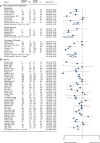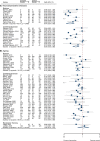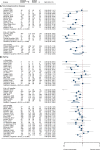Exercise for prevention of falls and fall-related injuries in neurodegenerative diseases and aging-related risk conditions: a meta-analysis
- PMID: 37534209
- PMCID: PMC10393124
- DOI: 10.3389/fendo.2023.1187325
Exercise for prevention of falls and fall-related injuries in neurodegenerative diseases and aging-related risk conditions: a meta-analysis
Abstract
Introduction: Neurodegenerative diseases often cause motor and cognitive deterioration that leads to postural instability and motor impairment, while aging-associated frailty frequently results in reduced muscle mass, balance, and mobility. These conditions increase the risk of falls and injuries in these populations. This study aimed to determine the effects of exercise on falls and consequent injuries among individuals with neurodegenerative diseases and frail aging people.
Methods: Electronic database searches were conducted in PubMed, Cochrane Library, SportDiscus, and Web of Science up to 1 January 2023. Randomized controlled trials that reported the effects of exercise on falls and fall-related injuries in neurodegenerative disease and frail aging people were eligible for inclusion. The intervention effects for falls, fractures, and injuries were evaluated by calculating the rate ratio (RaR) or risk ratio (RR) with 95% confidence interval (CI).
Results: Sixty-four studies with 13,241 participants met the inclusion criteria. Exercise is effective in reducing falls for frail aging people (RaR, 0.75; 95% CI, 0.68-0.82) and participants with ND (0.53, 0.43-0.65) [dementia (0.64, 0.51-0.82), Parkinson's disease (0.49, 0.39-0.69), and stroke survivors (0.40, 0.27-0.57)]. Exercise also reduced fall-related injuries in ND patients (RR, 0.66; 95% CI, 0.48-0.90) and decreased fractures (0.63, 0.41-0.95) and fall-related injuries (0.89, 0.84-0.95) among frail aging people. For fall prevention, balance and combined exercise protocols are both effective, and either short-, moderate-, or long-term intervention duration is beneficial. More importantly, exercise only induced a very low injury rate per participant year (0.007%; 95% CI, 0-0.016) and show relatively good compliance with exercise (74.8; 95% CI, 69.7%-79.9%).
Discussion: Exercise is effective in reducing neurodegenerative disease- and aging-associated falls and consequent injuries, suggesting that exercise is an effective and feasible strategy for the prevention of falls.
Keywords: aging; exercise; fall-related injuries; falls; neurodegenerative diseases.
Copyright © 2023 Feng, Xu, Sun, Zhang, Li, Sun, Tian and Zhao.
Conflict of interest statement
The authors declare that the research was conducted in the absence of any commercial or financial relationships that could be construed as a potential conflict of interest.
Figures





Similar articles
-
Prevention of falls and fall-related injuries in community-dwelling seniors: an evidence-based analysis.Ont Health Technol Assess Ser. 2008;8(2):1-78. Epub 2008 Oct 1. Ont Health Technol Assess Ser. 2008. PMID: 23074507 Free PMC article.
-
The efficacy and safety of exercise for prevention of fall-related injuries in older people with different health conditions, and differing intervention protocols: a meta-analysis of randomized controlled trials.BMC Geriatr. 2019 Dec 3;19(1):341. doi: 10.1186/s12877-019-1359-9. BMC Geriatr. 2019. PMID: 31795944 Free PMC article.
-
Exercise for preventing falls in older people living in the community.Cochrane Database Syst Rev. 2019 Jan 31;1(1):CD012424. doi: 10.1002/14651858.CD012424.pub2. Cochrane Database Syst Rev. 2019. PMID: 30703272 Free PMC article.
-
Exercise interventions and prevention of fall-related fractures in older people: a meta-analysis of randomized controlled trials.Int J Epidemiol. 2017 Feb 1;46(1):149-161. doi: 10.1093/ije/dyw142. Int J Epidemiol. 2017. PMID: 27477031 Review.
-
Physical activity as a risk or protective factor for falls and fall-related fractures in non-frail and frail older adults: a longitudinal study.BMC Geriatr. 2022 Aug 22;22(1):695. doi: 10.1186/s12877-022-03383-y. BMC Geriatr. 2022. PMID: 35996101 Free PMC article.
Cited by
-
Special Issue "Molecular Insights into the Role of Exercise in Disease and Health".Int J Mol Sci. 2025 Mar 25;26(7):2954. doi: 10.3390/ijms26072954. Int J Mol Sci. 2025. PMID: 40243561 Free PMC article.
-
The Right to Rehabilitation for People With Dementia: A Codesign Approach to Barriers and Solutions.Health Expect. 2024 Oct;27(5):e70036. doi: 10.1111/hex.70036. Health Expect. 2024. PMID: 39318228 Free PMC article.
-
Knowledge mapping and research trends of accidental falls in patients with Parkinson's disease from 2003 to 2023: a bibliometric analysis.Front Neurol. 2024 Aug 22;15:1443799. doi: 10.3389/fneur.2024.1443799. eCollection 2024. Front Neurol. 2024. PMID: 39239396 Free PMC article.
References
-
- Stewart Williams J, Kowal P, Hestekin H, O'Driscoll T, Peltzer K, Yawson A, et al. . Prevalence, risk factors and disability associated with fall-related injury in older adults in low- and middle-incomecountries: results from the WHO study on global AGEing and adult health (SAGE). BMC Med (2015) 13:147. doi: 10.1186/s12916-015-0390-8 - DOI - PMC - PubMed
Publication types
MeSH terms
LinkOut - more resources
Full Text Sources
Medical
Miscellaneous

